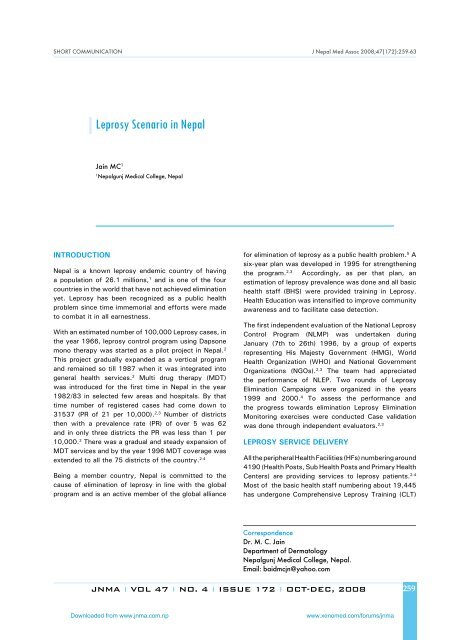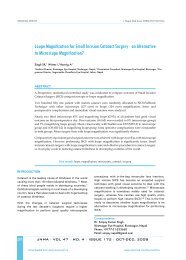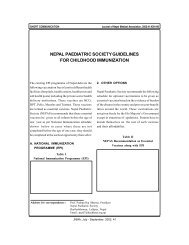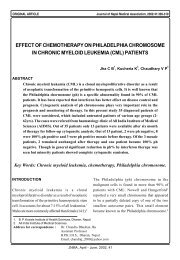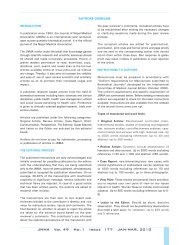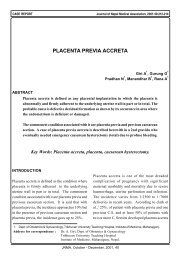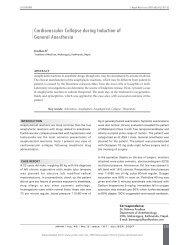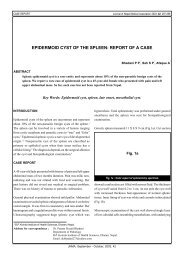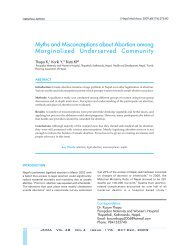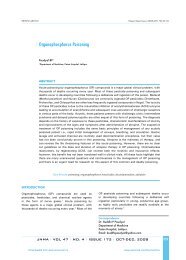Leprosy Scenario in Nepal - Journal of Nepal Medical Association
Leprosy Scenario in Nepal - Journal of Nepal Medical Association
Leprosy Scenario in Nepal - Journal of Nepal Medical Association
Create successful ePaper yourself
Turn your PDF publications into a flip-book with our unique Google optimized e-Paper software.
SHORT COMMUNICATION J <strong>Nepal</strong> Med Assoc 2008;47(172):259-63<br />
<strong>Leprosy</strong> <strong>Scenario</strong> <strong>in</strong> <strong>Nepal</strong><br />
Ja<strong>in</strong> MC 1<br />
1<br />
<strong>Nepal</strong>gunj <strong>Medical</strong> College, <strong>Nepal</strong><br />
INTRODUCTION<br />
<strong>Nepal</strong> is a known leprosy endemic country <strong>of</strong> hav<strong>in</strong>g<br />
a population <strong>of</strong> 26.1 millions, 1 and is one <strong>of</strong> the four<br />
countries <strong>in</strong> the world that have not achieved elim<strong>in</strong>ation<br />
yet. <strong>Leprosy</strong> has been recognized as a public health<br />
problem s<strong>in</strong>ce time immemorial and efforts were made<br />
to combat it <strong>in</strong> all earnestness.<br />
With an estimated number <strong>of</strong> 100,000 <strong>Leprosy</strong> cases, <strong>in</strong><br />
the year 1966, leprosy control program us<strong>in</strong>g Dapsone<br />
mono therapy was started as a pilot project <strong>in</strong> <strong>Nepal</strong>. 2<br />
This project gradually expanded as a vertical program<br />
and rema<strong>in</strong>ed so till 1987 when it was <strong>in</strong>tegrated <strong>in</strong>to<br />
general health services. 2 Multi drug therapy (MDT)<br />
was <strong>in</strong>troduced for the first time <strong>in</strong> <strong>Nepal</strong> <strong>in</strong> the year<br />
1982/83 <strong>in</strong> selected few areas and hospitals. By that<br />
time number <strong>of</strong> registered cases had come down to<br />
31537 (PR <strong>of</strong> 21 per 10,000). 2,3 Number <strong>of</strong> districts<br />
then with a prevalence rate (PR) <strong>of</strong> over 5 was 62<br />
and <strong>in</strong> only three districts the PR was less than 1 per<br />
10,000. 2 There was a gradual and steady expansion <strong>of</strong><br />
MDT services and by the year 1996 MDT coverage was<br />
extended to all the 75 districts <strong>of</strong> the country. 2-4<br />
Be<strong>in</strong>g a member country, <strong>Nepal</strong> is committed to the<br />
cause <strong>of</strong> elim<strong>in</strong>ation <strong>of</strong> leprosy <strong>in</strong> l<strong>in</strong>e with the global<br />
program and is an active member <strong>of</strong> the global alliance<br />
for elim<strong>in</strong>ation <strong>of</strong> leprosy as a public health problem. 5 A<br />
six-year plan was developed <strong>in</strong> 1995 for strengthen<strong>in</strong>g<br />
the program. 2,3 Accord<strong>in</strong>gly, as per that plan, an<br />
estimation <strong>of</strong> leprosy prevalence was done and all basic<br />
health staff (BHS) were provided tra<strong>in</strong><strong>in</strong>g <strong>in</strong> <strong>Leprosy</strong>.<br />
Health Education was <strong>in</strong>tensified to improve community<br />
awareness and to facilitate case detection.<br />
The first <strong>in</strong>dependent evaluation <strong>of</strong> the National <strong>Leprosy</strong><br />
Control Program (NLMP) was undertaken dur<strong>in</strong>g<br />
January (7th to 26th) 1996, by a group <strong>of</strong> experts<br />
represent<strong>in</strong>g His Majesty Government (HMG), World<br />
Health Organization (WHO) and National Government<br />
Organizations (NGOs). 2,3 The team had appreciated<br />
the performance <strong>of</strong> NLEP. Two rounds <strong>of</strong> <strong>Leprosy</strong><br />
Elim<strong>in</strong>ation Campaigns were organized <strong>in</strong> the years<br />
1999 and 2000. 4 To assess the performance and<br />
the progress towards elim<strong>in</strong>ation <strong>Leprosy</strong> Elim<strong>in</strong>ation<br />
Monitor<strong>in</strong>g exercises were conducted Case validation<br />
was done through <strong>in</strong>dependent evaluators. 2,3<br />
<strong>Leprosy</strong> service delivery<br />
All the peripheral Health Facilities (HFs) number<strong>in</strong>g around<br />
4190 (Health Posts, Sub Health Posts and Primary Health<br />
Centers) are provid<strong>in</strong>g services to leprosy patients. 2-4<br />
Most <strong>of</strong> the basic health staff number<strong>in</strong>g about 19,445<br />
has undergone Comprehensive <strong>Leprosy</strong> Tra<strong>in</strong><strong>in</strong>g (CLT)<br />
Correspondence<br />
Dr. M. C. Ja<strong>in</strong><br />
Department <strong>of</strong> Dermatology<br />
<strong>Nepal</strong>gunj <strong>Medical</strong> College, <strong>Nepal</strong>.<br />
Email: baidmcjn@yahoo.com<br />
JNMA I VOL 47 I NO. 4 I ISSUE 172 I OCT-DEC, 2008 259<br />
Downloaded from www.jnma.com.np<br />
www.xenomed.com/forums/jnma
Ja<strong>in</strong>. <strong>Leprosy</strong> <strong>Scenario</strong> <strong>in</strong> <strong>Nepal</strong><br />
and a majority <strong>of</strong> them an additional Refresher <strong>Leprosy</strong><br />
Tra<strong>in</strong><strong>in</strong>g (RLT) as well. 3,4 These health facilities (HFs)<br />
carry out leprosy diagnosis and treatment services,<br />
patient counsel<strong>in</strong>g, contact exam<strong>in</strong>ation, community<br />
health education, focal case detection drives, treatment<br />
<strong>of</strong> m<strong>in</strong>or complications and referral services. In addition<br />
over 90% <strong>of</strong> Female Community Health Volunteers<br />
have been provided with orientation tra<strong>in</strong><strong>in</strong>g. 4 There<br />
is a good network <strong>of</strong> Referral Centers managed b<br />
<strong>in</strong>ternational government organizations (INGO’s)/NGOs<br />
that are provid<strong>in</strong>g secondary and tertiary general health<br />
care <strong>in</strong> the country. 2<br />
on 15 th July 2007. The fiscal year 2006/07 has shown<br />
an over all 11.7 % decrease <strong>in</strong> registered cases. 4<br />
Managerial support<br />
District <strong>Leprosy</strong> and Tuberculosis assistant posted at<br />
each district is the first l<strong>in</strong>e manager and is provid<strong>in</strong>g<br />
managerial and technical support to the staff work<strong>in</strong>g at<br />
HFs. 4 At the regional level there is regional tuberculosis<br />
leprosy assistant (RTLA) to assist the program. 2 There<br />
is a <strong>Leprosy</strong> Control Division located at the center<br />
headed by Director, ma<strong>in</strong>ly responsible for lay<strong>in</strong>g down<br />
the policy, decid<strong>in</strong>g on the strategy <strong>of</strong> leprosy control<br />
and issu<strong>in</strong>g periodically updated national guidel<strong>in</strong>es for<br />
leprosy control activities <strong>in</strong> the country. 4<br />
There are several partners (INGOs and NGOs) who<br />
provide human, material and f<strong>in</strong>ancial support to<br />
NLEP. The major partners are The <strong>Leprosy</strong> Mission<br />
International, Sasakawa Memorial Health Foundation,<br />
Netherlands <strong>Leprosy</strong> Relief <strong>Association</strong>, International<br />
<strong>Nepal</strong> Foundation, <strong>Nepal</strong> <strong>Leprosy</strong> Fellowship and <strong>Nepal</strong><br />
<strong>Leprosy</strong> Trust. 2-4<br />
NLEP Objectives:<br />
Follow<strong>in</strong>g are the explicitly stated objectives <strong>of</strong> NLEP. 4<br />
• To reduce PR to
Ja<strong>in</strong>. <strong>Leprosy</strong> <strong>Scenario</strong> <strong>in</strong> <strong>Nepal</strong><br />
Registered cases<br />
New case detection 2006/07<br />
Dur<strong>in</strong>g the year 2006/07 a total <strong>of</strong> 4317 new leprosy<br />
cases were detected. Among these new cases detected<br />
dur<strong>in</strong>g the second quarter there were women patients<br />
were 23.1 % and Children were 6 %. Proportion <strong>of</strong> MB<br />
cases was 55%. Proportion <strong>of</strong> leprosy cases hav<strong>in</strong>g<br />
disability GR II at the time <strong>of</strong> detection was giv<strong>in</strong>g a<br />
Disability rate <strong>of</strong> 5.56 %. 4<br />
Treatment compliance cont<strong>in</strong>ue to be good <strong>in</strong> <strong>Nepal</strong><br />
however this year saw an <strong>in</strong>crease <strong>in</strong> PD ratio from<br />
0.84 (2005/06) to 0.88 (2006/07). 4 The ratio rema<strong>in</strong>ed<br />
less than one <strong>in</strong> all regions barr<strong>in</strong>g two namely FWDR In<br />
the figure 6 and 7 below trends over the past five years<br />
<strong>of</strong> important <strong>in</strong>dicators is given. 4<br />
Fig 3. Cases detected and registered <strong>in</strong> 5 regions<br />
EDR=Eastern Development region, CDR=Central<br />
Development Region, WDR=Western Development<br />
Region, MWDR=Mid-west Development Region,<br />
FWDR=Far-western Development Region, NCDR=New<br />
Case Detection Rate<br />
Regionwise PR(14/7/07)<br />
Fig 5. Trends <strong>in</strong> selected <strong>in</strong>dicators over the past 5<br />
years<br />
Regionwise NCDR(2006/07)<br />
Fig6. Trends <strong>in</strong> DR GR II among new cases<br />
Fig 4. Region wise PR and NCDR<br />
Figures above reveal that maximum numbers <strong>of</strong> cases are<br />
form CDR followed by EDR where as the PR is highest <strong>in</strong><br />
FWDR (1.68) and least <strong>in</strong> western development region<br />
(WDR) and highest new case detection rate (NCDR) is<br />
reported from EDR (2/10,000). 4<br />
Figures 6 and 7 show that the <strong>in</strong>dicators are by and<br />
large stable except<strong>in</strong>g that dur<strong>in</strong>g the last year DR has<br />
gone up and Female proportion among new cases has<br />
come down.<br />
With the cont<strong>in</strong>uation <strong>of</strong> current decl<strong>in</strong><strong>in</strong>g trend and<br />
same level <strong>of</strong> leprosy control activities PR by the year<br />
end <strong>of</strong> 2007 was expected to cross over to less than<br />
one. 4<br />
JNMA I VOL 47 I NO. 4 I ISSUE 172 I OCT-DEC, 2008 261<br />
Downloaded from www.jnma.com.np<br />
www.xenomed.com/forums/jnma
Ja<strong>in</strong> . <strong>Leprosy</strong> <strong>Scenario</strong> <strong>in</strong> <strong>Nepal</strong><br />
to lack <strong>of</strong> demand. Hence there is an urgent need to<br />
undertake an <strong>in</strong> depth evaluation <strong>of</strong> leprosy tra<strong>in</strong><strong>in</strong>g.<br />
<strong>Leprosy</strong> Control Division <strong>in</strong> particular and the programme<br />
<strong>in</strong> general is heavily dependent on external support from<br />
either INGOs or WHO.<br />
Fig 7. Projected trend <strong>in</strong> PR <strong>in</strong> <strong>Nepal</strong><br />
The projections did not come true. Decl<strong>in</strong><strong>in</strong>g trend<br />
cont<strong>in</strong>ued but at a reduced rate dur<strong>in</strong>g the last year.<br />
Some <strong>of</strong> the planned activities could not be carried out<br />
<strong>in</strong> endemic districts due to disturbances.<br />
Challenges<br />
In spite <strong>of</strong> the consistently decl<strong>in</strong><strong>in</strong>g PR the country<br />
has not reached elim<strong>in</strong>ation level. Additional efforts are<br />
needed to expedite the process <strong>of</strong> elim<strong>in</strong>ation. Uneven<br />
distribution <strong>of</strong> registered cases number<strong>in</strong>g a mere 3786<br />
had resulted <strong>in</strong> the districts with no cases, districts<br />
with sporadic cases, low endemic districts and endemic<br />
districts. This calls for a realistic and practical area<br />
specific approach.<br />
There are few districts and areas with<strong>in</strong> the districts that<br />
throw up large number <strong>of</strong> new cases year after year.<br />
The control activities are either grossly <strong>in</strong>adequate or<br />
these areas are relatively <strong>in</strong>accessible. May be there are<br />
some yet unknown factors operat<strong>in</strong>g that has favored a<br />
high <strong>in</strong>tensity <strong>of</strong> leprosy transmission. These areas can<br />
not be left alone. They have to be mapped and mopped<br />
up so as to prevent them from becom<strong>in</strong>g the source for<br />
future resurgence <strong>of</strong> leprosy.<br />
Present policy <strong>of</strong> provid<strong>in</strong>g MDT services at all peripheral<br />
health facilities particularly <strong>in</strong> very low endemic districts<br />
is not practical and becom<strong>in</strong>g <strong>in</strong>creas<strong>in</strong>gly cost <strong>in</strong><br />
effective. Alternate approaches that are cost effective<br />
have to be identified and implemented.<br />
Tasks <strong>in</strong>volved <strong>in</strong> client management go unsupervised<br />
by first l<strong>in</strong>e managers. Most <strong>of</strong> the time supervision<br />
is limited to perus<strong>in</strong>g records and reports. As a result<br />
NLEP is forced to organize special activities to monitor<br />
diagnostic efficiency <strong>of</strong> staff. Case review should<br />
become a rout<strong>in</strong>e task <strong>of</strong> supervisors.<br />
Most <strong>of</strong> the tra<strong>in</strong>ed manpower rema<strong>in</strong>s under and or<br />
unutilized either due to <strong>in</strong>adequate motivation or due<br />
On go<strong>in</strong>g persistent agitation <strong>in</strong> the pla<strong>in</strong>s has affected<br />
movement <strong>in</strong> few districts <strong>of</strong> CDR and EDR. The<br />
districts that are affected most by agitation <strong>in</strong>cidentally<br />
are the districts <strong>of</strong> very high case load. For the time<br />
be<strong>in</strong>g implementation <strong>of</strong> activities aimed at expedit<strong>in</strong>g<br />
elim<strong>in</strong>ation <strong>in</strong> these districts is quite uncerta<strong>in</strong>.<br />
Proposed additional activities<br />
Detection and deletion <strong>of</strong> cases <strong>in</strong>appropriately<br />
registered has to be undertaken <strong>in</strong> endemic district<br />
so as to expedite elim<strong>in</strong>ation. In addition updat<strong>in</strong>g <strong>of</strong><br />
records and ensur<strong>in</strong>g correct data compilation will also<br />
help <strong>in</strong> m<strong>in</strong>imiz<strong>in</strong>g errors <strong>in</strong> data aggregation. 4<br />
Phases and planned centralization <strong>of</strong> service delivery<br />
at selected few po<strong>in</strong>ts will facilitate susta<strong>in</strong><strong>in</strong>g quality<br />
service delivery at an affordable cost.<br />
Involv<strong>in</strong>g medical colleges <strong>in</strong> capacity build<strong>in</strong>g and<br />
provision <strong>of</strong> secondary care to leprosy patients will<br />
ensure susta<strong>in</strong>ability.<br />
conclusion<br />
<strong>Nepal</strong> is one <strong>of</strong> the four countries <strong>in</strong> the world that<br />
has not yet achieved elim<strong>in</strong>ation <strong>of</strong> leprosy as a public<br />
health problem though the country has been report<strong>in</strong>g<br />
a steady decl<strong>in</strong>e both <strong>in</strong> PR and NCDR but the decl<strong>in</strong>e<br />
is not fast enough to reach elim<strong>in</strong>ation by the end <strong>of</strong><br />
2007. It has been observed that Operational factors<br />
such as re-registration, registration <strong>of</strong> Indian cases and<br />
wrong diagnosis have a significant role <strong>in</strong> <strong>in</strong>flat<strong>in</strong>g PR<br />
<strong>in</strong> <strong>Nepal</strong>. Case hold<strong>in</strong>g <strong>in</strong> <strong>Nepal</strong> is exceptionally good<br />
with the cure rates <strong>of</strong> over 91% for MB and 94% for<br />
PB cases. Endemicity <strong>of</strong> leprosy is ma<strong>in</strong>ly localized to<br />
Terai region account<strong>in</strong>g for 80% cases under treatment<br />
and 82% new cases detected. An effective cross<br />
referral system is <strong>in</strong> place. Program is assisted by a<br />
good network <strong>of</strong> support<strong>in</strong>g partners. Concerted efforts<br />
are be<strong>in</strong>g made to m<strong>in</strong>imize the operational factors and<br />
improve the quality <strong>of</strong> leprosy services <strong>in</strong> order to atta<strong>in</strong><br />
the goal <strong>of</strong> leprosy elim<strong>in</strong>ation as soon as possible.<br />
262<br />
JNMA I VOL 47 I NO. 4 I ISSUE 172 I OCT-DEC, 2008<br />
Downloaded from www.jnma.com.np<br />
www.xenomed.com/forums/jnma
Ja<strong>in</strong>. <strong>Leprosy</strong> <strong>Scenario</strong> <strong>in</strong> <strong>Nepal</strong><br />
References<br />
1. M<strong>in</strong>istry <strong>of</strong> Population and Environment and Central Bureau<br />
<strong>of</strong> Statistics. Population Projections for <strong>Nepal</strong> 2001-2007.<br />
Kathmandu: M<strong>in</strong>istry <strong>of</strong> Population and Environment and<br />
Central Bureau <strong>of</strong> Statistics <strong>Nepal</strong>; 2003.<br />
2. <strong>Leprosy</strong> Control Division, Department <strong>of</strong> Health Services,<br />
His Majesty’s Government <strong>of</strong> <strong>Nepal</strong> M<strong>in</strong>istry <strong>of</strong> Health<br />
and Population. Annual report 2062/2063 (2005/2006).<br />
Kathmandu: <strong>Leprosy</strong> Control Division; 2006 Nov 7. 29p.<br />
3. <strong>Leprosy</strong> Control Division, Department <strong>of</strong> Health Services,<br />
His Majesty’s Government <strong>of</strong> <strong>Nepal</strong> M<strong>in</strong>istry <strong>of</strong> Health<br />
and Population. Annual report 2061/2062 (2004/2005).<br />
Kathmandu: <strong>Leprosy</strong> Control Division; 2005 Oct 9. 20p.<br />
4. <strong>Leprosy</strong> Control Division, Department <strong>of</strong> Health Services,<br />
His Majesty’s Government <strong>of</strong> <strong>Nepal</strong> M<strong>in</strong>istry <strong>of</strong> Health and<br />
Population. Annual report 2063/2064 (2006/2007) 1 st Draft.<br />
Kathmandu: <strong>Leprosy</strong> Control Division; 2007. 30p.<br />
5. World Health Organization. Global Strategy for Further<br />
Reduc<strong>in</strong>g the <strong>Leprosy</strong> Burden and Susta<strong>in</strong><strong>in</strong>g <strong>Leprosy</strong><br />
Control Activities (2006-2010) Operational Guidel<strong>in</strong>es. New<br />
Delhi: WHO; 2006. 50p. Report no.:SEA/GLP/2006.2.<br />
JNMA I VOL 47 I NO. 4 I ISSUE 172 I OCT-DEC, 2008 263<br />
Downloaded from www.jnma.com.np<br />
www.xenomed.com/forums/jnma


